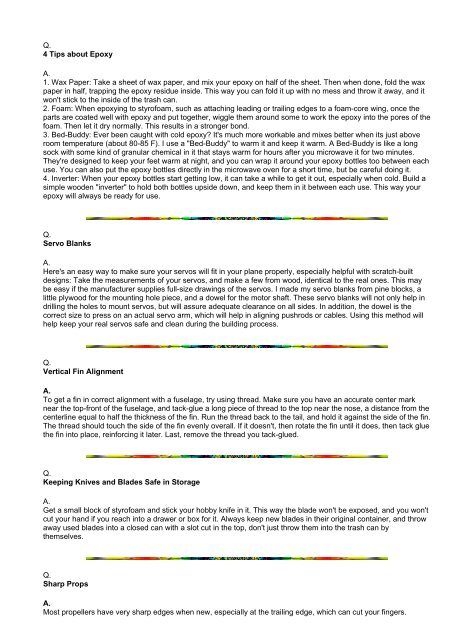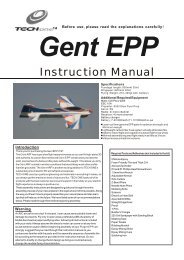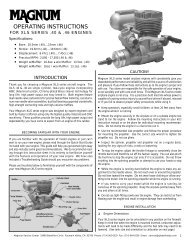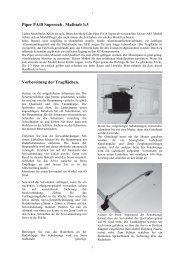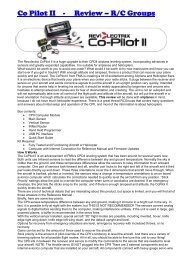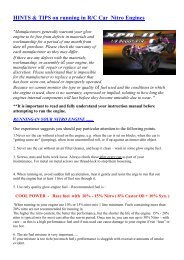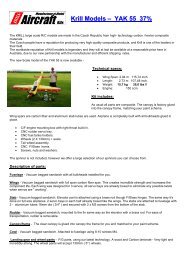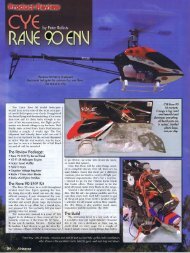Create successful ePaper yourself
Turn your PDF publications into a flip-book with our unique Google optimized e-Paper software.
Q.4 <strong>Tips</strong> about EpoxyA.1. Wax Paper: Take a sheet <strong>of</strong> wax paper, and mix your epoxy on half <strong>of</strong> the sheet. Then when done, fold the waxpaper in half, trapping the epoxy residue inside. This way you can fold it up with no mess and throw it away, and itwon't stick to the inside <strong>of</strong> the trash can.2. Foam: When epoxying to styr<strong>of</strong>oam, such as attaching leading or trailing edges to a foam-core wing, once theparts are coated well with epoxy and put together, wiggle them around some to work the epoxy into the pores <strong>of</strong> thefoam. Then let it dry normally. This results in a stronger bond.3. Bed-Buddy: Ever been caught with cold epoxy? It's much more workable and mixes better when its just aboveroom temperature (about 80-85 F). I use a "Bed-Buddy" to warm it and keep it warm. A Bed-Buddy is like a longsock with some kind <strong>of</strong> granular chemical in it that stays warm for hours after you microwave it for two minutes.They're designed to keep your feet warm at night, and you can wrap it around your epoxy bottles too between eachuse. You can also put the epoxy bottles directly in the microwave oven for a short time, but be careful doing it.4. Inverter: When your epoxy bottles start getting low, it can take a while to get it out, especially when cold. Build asimple wooden "inverter" to hold both bottles upside down, and keep them in it between each use. This way yourepoxy will always be ready for use.Q.Servo BlanksA.Here's an easy way to make sure your servos will fit in your plane properly, especially helpful with scratch-builtdesigns: Take the measurements <strong>of</strong> your servos, and make a few from wood, identical to the real ones. This maybe easy if the manufacturer supplies full-size drawings <strong>of</strong> the servos. I made my servo blanks from pine blocks, alittle plywood for the mounting hole piece, and a dowel for the motor shaft. These servo blanks will not only help indrilling the holes to mount servos, but will assure adequate clearance on all sides. In addition, the dowel is thecorrect size to press on an actual servo arm, which will help in aligning pushrods or cables. Using this method willhelp keep your real servos safe and clean during the building process.Q.Vertical Fin AlignmentA.To get a fin in correct alignment with a fuselage, try using thread. Make sure you have an accurate center marknear the top-front <strong>of</strong> the fuselage, and tack-glue a long piece <strong>of</strong> thread to the top near the nose, a distance from thecenterline equal to half the thickness <strong>of</strong> the fin. Run the thread back to the tail, and hold it against the side <strong>of</strong> the fin.The thread should touch the side <strong>of</strong> the fin evenly overall. If it doesn't, then rotate the fin until it does, then tack gluethe fin into place, reinforcing it later. Last, remove the thread you tack-glued.Q.Keeping Knives and Blades Safe in StorageA.Get a small block <strong>of</strong> styr<strong>of</strong>oam and stick your hobby knife in it. This way the blade won't be exposed, and you won'tcut your hand if you reach into a drawer or box for it. Always keep new blades in their original container, and throwaway used blades into a closed can with a slot cut in the top, don't just throw them into the trash can bythemselves.Q.Sharp PropsA.Most propellers have very sharp edges when new, especially at the trailing edge, which can cut your fingers.


